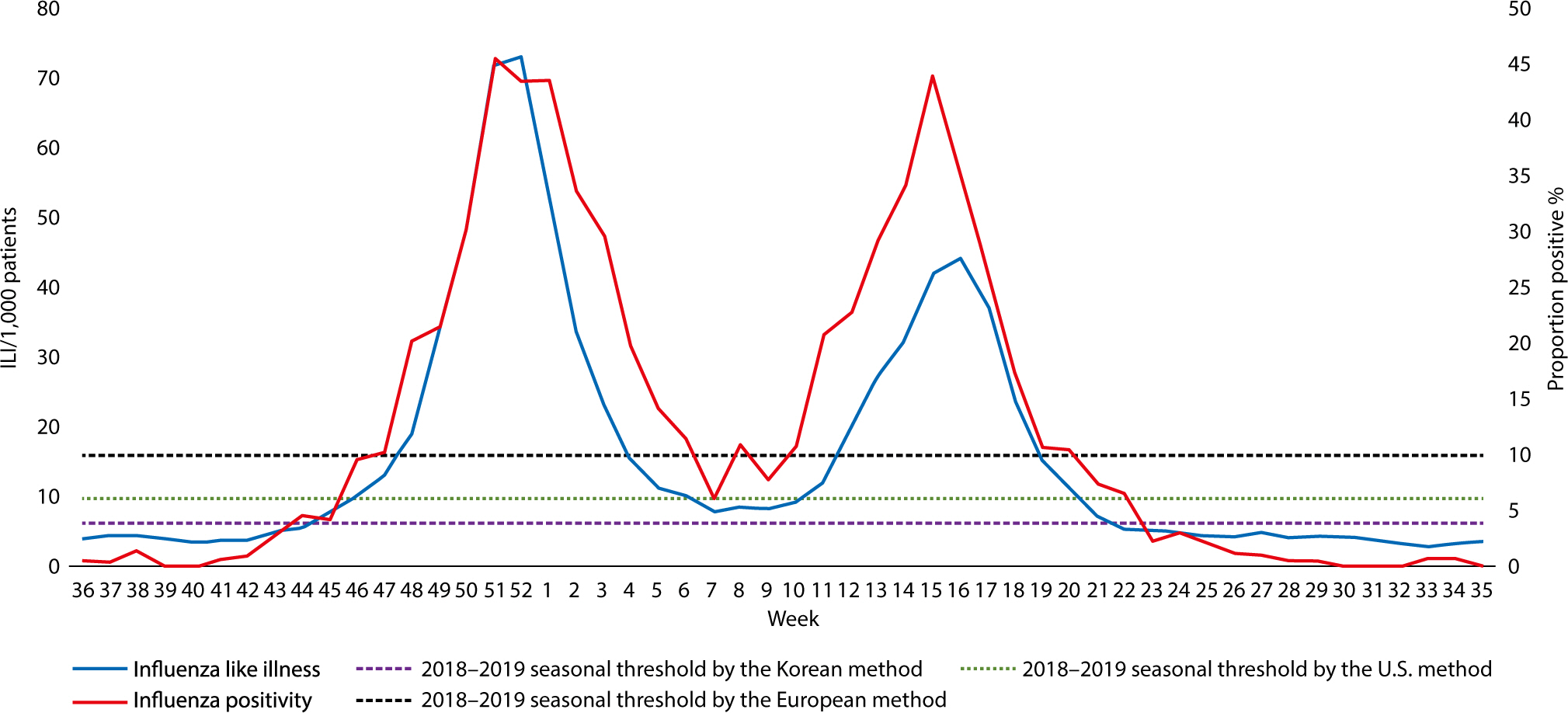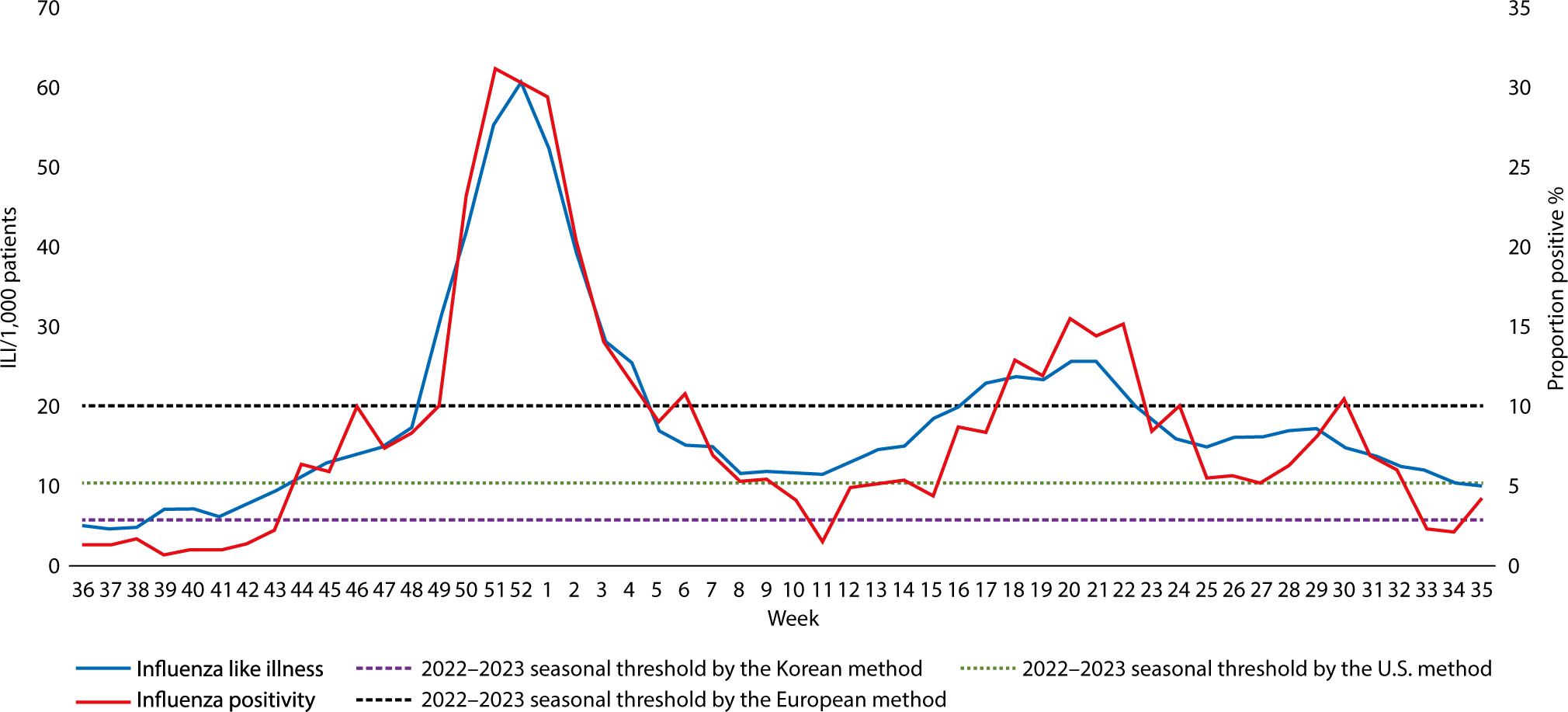Ewha Med J.
2024 Apr;47(2):e24. 10.12771/emj.2024.e24.
Using an influenza epidemic threshold different from those in the United States and Europe caused longer epidemic periods in Korea during the 2018– 2019, 2019–2020, and 2022–2023 seasons: a comparative study
- Affiliations
-
- 1Infectious Disease Research Center, Citizen’s Health Bureau, Seoul Metropolitan Government, Seoul, Korea
- KMID: 2556313
- DOI: http://doi.org/10.12771/emj.2024.e24
Abstract
Objectives
During the COVID-19 pandemic, the first seasonal influenza epidemic was declared in the 37th week of 2022 in Korea and has continued through the winter of 2023–2024. However, this finding has not been observed in the United States and Europe. The present study aimed to determine whether the prolonged influenza epidemic in Korea from 2022 to 2023 was caused by using a different influenza epidemic threshold compared to the thresholds used in the United States and Europe.
Methods
Korea, the United States, and Europe use different methods to set seasonal influenza epidemic thresholds. First, we calculated the influenza epidemic thresholds for influenza seasons using the different methods of those three regions. Using these epidemic thresholds, we then compared the duration of influenza epidemics for the most recent three influenza seasons.
Results
The epidemic thresholds estimated by the Korean method were lower than those by the other methods, and the epidemic periods defined using the Korean threshold were estimated to be longer than those defined by the other regions’ thresholds.
Conclusion
A low influenza epidemic threshold may have contributed to the prolonged influenza epidemic in Korea, which was declared in 2022 and has continued until late 2023. A more reliable epidemic threshold for seasonal influenza surveillance needs to be established in Korea.
Keyword
Figure
Reference
-
References
1. Biggerstaff M, Cauchemez S, Reed C, Gambhir M, Finelli L. Estimates of the reproduction number for seasonal, pandemic, and zoonotic influenza: a systematic review of the literature. BMC Infect Dis. 2014; 14:480. DOI: 10.1186/1471-2334-14-480. PMID: 25186370. PMCID: PMC4169819.2. Korea Disease Control and Prevention Agency. Management strategies for seasonal influenza, 2023-24 season. Cheongju: Korea Disease Control and Prevention Agency;2023.3. Centers for Disease Control and Prevention [CDC]. U.S. influenza surveillance: purpose and methods [Internet]. Atlanta (GA): CDC;c2024. [cited 2024 Jan 5]. Available from. https://www.cdc.gov/flu/weekly/overview.htm.4. Brammer L, Budd A, Cox N. Seasonal and pandemic influenza surveillance considerations for constructing multicomponent systems. Influenza Other Respir Viruses. 2009; 3(2):51–58. DOI: 10.1111/j.1750-2659.2009.00077.x. PMID: 19496841. PMCID: PMC4634524.5. Spencer JA, Shutt DP, Moser SK, Clegg H, Wearing HJ, Mukundan H, et al. Distinguishing viruses responsible for influenza-like illness. J Theor Biol. 2022; 545:111145. DOI: 10.1016/j.jtbi.2022.111145. PMID: 35490763.6. European Centre for Disease Prevention and Control [ECDC]. Seasonal influenza 2022-2023: annual epidemiological report for 2023. Stockholm: ECDC;2023.7. Korea Disease Control and Prevention Agency. Announcement of 2023-2024 influenza season initiation [Internet]. Cheongju (KR): Korea Disease Control and Prevention Agency;c2023. [cited 2024 Jan 5]. Available from. https://www.kdca.go.kr/board/board.es?mid=a20501010000&bid=0015&list_no=723470&cg_code=&act=view&nPage=1.8. Tamerius JD, Shaman J, Alonso WJ, Bloom-Feshbach K, Uejio CK, Comrie A, et al. Environmental predictors of seasonal influenza epidemics across temperate and tropical climates. PLOS Pathog. 2013; 9(3):e1003194. DOI: 10.1371/journal.ppat.1003194. PMID: 23505366. PMCID: PMC3591336.9. Korea Disease Control and Prevention Agency. 2022 Annual report on infectious disease reports [Internet]. Cheongju (KR): Korea Disease Control and Prevention Agency;c2022. [cited 2024 Feb 16]. Available from. https://dportal.kdca.go.kr/pot/bbs/BD_selectBbs.do?q_bbsSn=1010&q_bbsDocNo=20230908669355443&q_clsfNo=1.10. Lee JW. Another flu season declaration… The first season continued for more than a year [Internet]. Seoul (KR): The Dong-a Ilbo;c2023. [cited 2023 Sep 15]. Available from. https://www.donga.com/news/Health/article/all/20230915/121190131/1.11. Korea Disease Control and Prevention Agency. Infectious diseases, sentinel surveillance report [Internet]. Cheongju (KR): Korea Disease Control and Prevention Agency;c2024. [cited 2024 Jan 5]. Available from. https://dportal.kdca.go.kr/pot/bbs/BD_selectBbsList.do?q_bbsSn=1010&q_bbsDocNo=&q_clsfNo=2&q_searchKeyTy=&q_searchVal=&q_currPage=1&q_sortName=&q_sortOrder=.12. Cha J, Seo Y, Kang S, Kim I, Gwack J. Sentinel surveillance results for influenza and acute respiratory infections during the coronavirus disease 2019 pandemic. Public Health Wkly Rep. 2023; 16(20):597–612. DOI: 10.56786/PHWR.2023.16.20.1.13. Kim IH, Kang SK, Cha JO, Seo YJ, Gwack J, Lee NJ, et al. Changes in patterns of respiratory virus since the coronavirus disease 2019 pandemic (until April 2023). Public Health Wkly Rep. 2023; 16(20):621–631. DOI: 10.56786/PHWR.2023.16.20.3.14. Lee NJ, Woo S, Lee J, Rhee JE, Kim EJ. 2021-2022 Influenza and respiratory viruses laboratory surveillance report in the Republic of Korea. Public Health Wkly Rep. 2023; 16(3):53–65. DOI: 10.56786/PHWR.2023.16.3.1.15. Woo SH, Lee NJ, Lee JH, Rhee JE, Kim EJ. Korea 2022-2023 influenza and respiratory viruses laboratory surveillance report. Public Health Wkly Rep. 2024; 17(2):455–469. DOI: 10.56786/PHWR.2024.17.12.1.16. de Jong SPJ, Felix Garza ZC, Gibson JC, van Leeuwen S, de Vries RP, Boons GJ, et al. Determinants of epidemic size and the impacts of lulls in seasonal influenza virus circulation. Nat Commun. 2024; 15(1):591. DOI: 10.1038/s41467-023-44668-z. PMID: 38238318. PMCID: PMC10796432.17. Fleming DM, Elliot AJ. Lessons from 40 years' surveillance of influenza in England and Wales. Epidemiol Infect. 2008; 136(7):866–875. DOI: 10.1017/S0950268807009910. PMID: 18047750. PMCID: PMC2870877.18. Kelly H, Birch C. The causes and diagnosis of influenza-like illness. Aust Fam Physician. 2004; 33(5):305–309.
- Full Text Links
- Actions
-
Cited
- CITED
-
- Close
- Share
- Similar articles
-
- Application of the Time Derivative (TD) Method for Early Alert of Influenza Epidemics
- Social Distancing against COVID-19: Implication for the Control of Influenza
- Epidemiological Characteristics of Influenza in Children during the 2017– 2018 and 2018–2019 Influenza Seasons in Jeju, Korea
- Post-recovery Stigma in Early and Late COVID-19 Epidemic
- Clinical Characteristics of Pediatric Patients With the Coronavirus Disease 2019 During the Third and Fourth Waves of the Epidemic in Korea: A Single Center Retrospective Study




